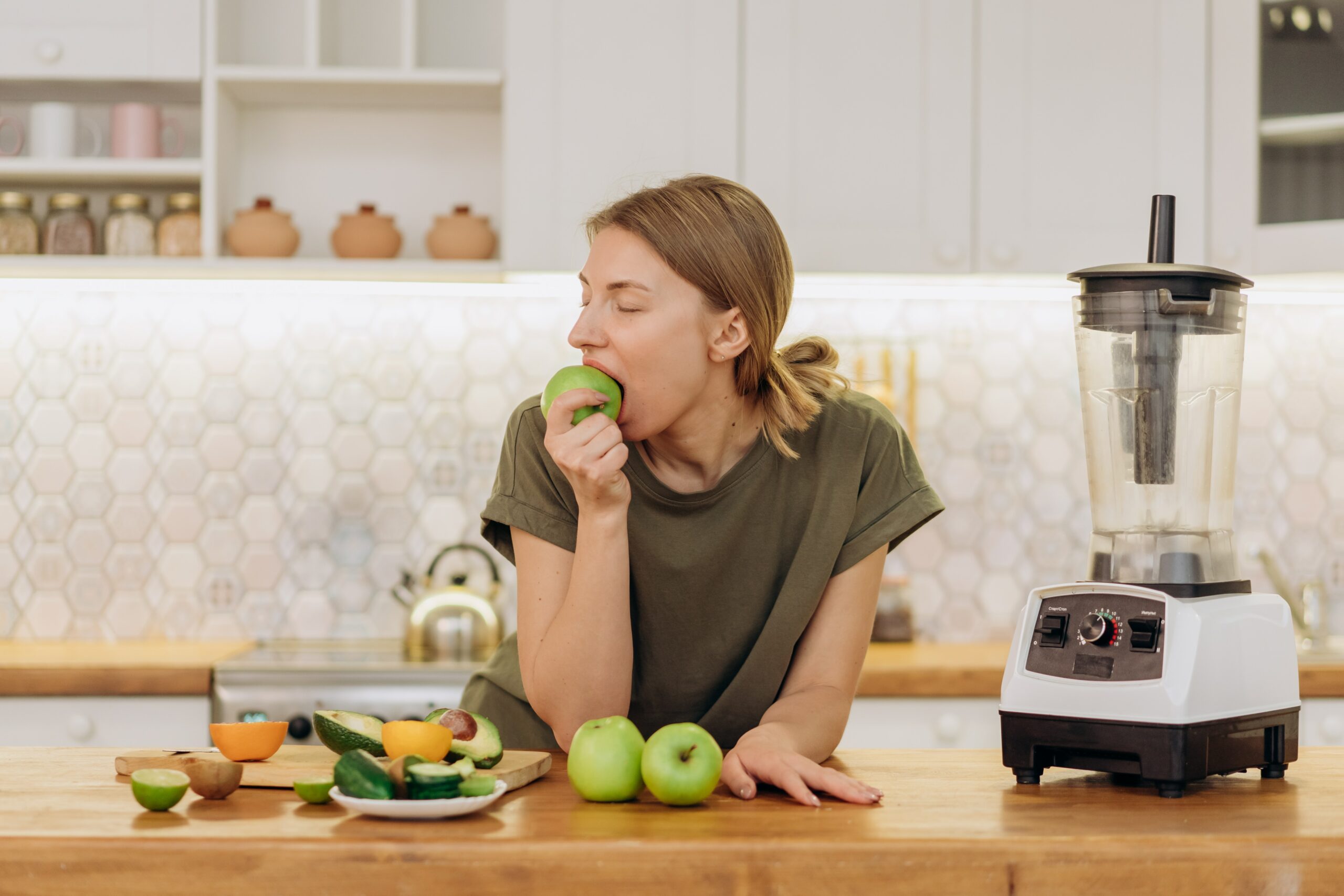How to Permanently Overcome Emotional Eating
“The maintenance of health really depends on knowing who you are, getting in touch with your body, getting in touch with yourself, being mindful of all of that, and honoring who you are.”
—Gabor Mate
It’s Saturday afternoon. You’ve been shuttling your kids to various activities all day. You sit down for a moment to rest. It’s been a week.
You remember there are cookies in the kitchen from your daughter’s birthday party. You have one then another then another then another.
You weren’t even hungry. You just wanted a cookie, and you just couldn’t stop for some reason. It just happened.
You feel like crap afterward.
You ask yourself what just happened, and you don’t have a good answer.
You’re a disciplined person. You get to work on time. You change the oil in your car. You have a good credit score. You have your life mostly under control.
But with food, sometimes you completely lose control.
This is emotional eating.
A Common Challenge
Food, especially junk food, especially sugary food can be addictive, and these addictions have been on the rise for decades:
In 1915, the average annual per-person sugar consumption in the United States was 17.5 pounds. Today, it’s 150 pounds. That means the average person in the United States consumes 25 teaspoons of sugar a day.
If you struggle with emotional eating, you’re certainly not alone.
Emotional eating isn’t an ethical or moral failing either. You’re not a bad person if you struggle with emotional eating.
Emotional eating is actually adaptive. You feel bad in some way, so you eat something as a way of making yourself feel better.
But you don’t feel better in a lasting way. In fact, you usually end up feeling lousy. Worse than you did before. And emotional eating could also be making it hard for you to maintain optimal blood-sugar levels, blood pressure, blood-cholesterol levels, and/or weight. As such, emotional eating, although adaptive in one sense, is ultimately maladaptive. That’s why most people who struggle with emotional eating want to overcome it.
Comfort and Compensation
I’ve coached hundreds of people who initially struggled with emotional eating. The overwhelming majority of them have told me their emotional eating happens when they’re bored, lonely, stressed, tired, and/or otherwise feeling bad. Sometimes these feelings are acute. Sometimes they’re chronic.
This gives us some insight into what’s actually going on with emotional eating:
- You feel bad in some way.
- Eating provides comfort.
- Eating is compensating for something else (the thing or things that are missing that are causing boredom, loneliness, stress, fatigue, and/or other bad feelings).
As such, a better name for emotional eating is comfort-compensatory eating.
When you think of it this way, you’re better equipped to work with it. You’re acknowledging you feel bad in some way. You’re acknowledging you could use some comfort. And you’re acknowledging the fact that eating is compensating for something else. These are all things you can work with.
Rat Park
Before we get to how to permanently overcome comfort-compensatory eating, let’s get a deeper understanding of how it works.
The best way to do that is by exploring heroin addiction.
For many years in the early 1900s, researchers conducted scientific studies in which they’d bring lab rats heroin and observe what happened. In short, rats given heroin would universally become addicted. Once rats were given heroin, they’d keep taking it until they killed themselves. If it was taken away before they killed themselves, they’d exhibit signs of withdrawal. Numerous scientific studies showed similar results. Researchers had all the evidence they needed: Heroin is very addictive.
Enter pioneering researcher Bruce Alexander in the 1970s who made an important observation: All of the rats in these heroin studies were living, as lab rats tend to do, in cages. This meant their day-to-day lives included very little contact with other rats, and the only people they saw were the people who brought them food, water, and, um, heroin, a few times a day for a few minutes of total time. Alexander hypothesized that this might be impacting the results of heroin studies.
Rats are used in scientific studies because their physiological and psychological characteristics are similar to those of humans. Like us humans, rats are highly social animals.
We all know what happens when a person goes into solitary confinement; they basically lose their s*** and go crazy. Solitary confinement is extremely difficult for a person. The rats being used in heroin studies were effectively living in solitary confinement for their entire lives. Alexander thought this might be important.
He made what came to be known as Rat Park, an area for rats to live outside of cages in something more like their natural environment. They had space to move around, plenty of water and food, toys rats love to play with, and each other.
Then he basically ran the same experiments that had been run in heroin studies countless times.
What did he find?
Rats living in Rat Park tried heroin when it was brought to them but didn’t become addicted. Rats who became addicted to heroin while living in cages recovered when brought to Rat Park even though heroin was readily available there. In cages, almost all rats given heroin became addicted and overdosed. In Rat Park, not a single rat became addicted or overdosed. (1,2,3)
Wow!
The results of Alexander’s Rat Park studies were validated by a 2010 scientific study of a similar nature. Here’s what the researchers reported:
“Adult Wistar rats housed in short-term isolation (21 days) consumed significantly more morphine solution (0.5 mg/ml) than rats living in pairs, both in one-bottle and in two-bottle tests. No differences were found in their water consumption. This effect was observed in both males and females and the results were also replicated after reversal of housing conditions. We also found that as little as 60-min of daily social-physical interaction with another rat was sufficient to completely abolish the increase in morphine consumption in socially restricted animals.” (4)
Rats that don’t have their needs met, when given heroin, became addicts.
Rats that have their needs met, when given heroin, don’t become addicts.
This is the fundamental phenomenon at play with comfort-compensatory eating.
A Very Simple Physiology and Psychology Lesson
When you proactively meet your needs, you experience optimal levels of the reward chemicals dopamine, serotonin, oxytocin, vasopressin, and endorphins.
When you experience optimal levels of reward chemicals, you feel good.
When fail to proactively meet your needs, you experience low levels of the reward chemicals dopamine, serotonin, oxytocin, vasopressin, and endorphins.
When you experience low levels of reward chemicals, you feel bad.
It’s human nature to move away from feeling bad. It’s human nature to move toward feeling good.
Eating food raises your reward-chemical levels and makes you feel good.
Eating junk food, especially sugary food, raises your reward-chemical levels faster and makes you feel good faster because you digest it faster.
A Better Name
Again, the term “emotional eating” doesn’t do the phenomenon of comfort-compensatory eating justice.
One implication of the word “emotional” as it’s commonly used is irrational. But I hope you can see now that comfort-compensatory eating makes perfect sense.
Another implication of the word “emotional” as it’s commonly used is nonphysical and intangible. But I hope you can see now that comfort compensatory eating is, in fact, a physical and tangible phenomenon.
This makes it much easier to work with.
One of the blessings of COVID-19 was an increasing number of people had conversations about comfort-compensatory eating. Lockdown measures created living conditions that made it much harder for many people to proactively meet their needs. While that led to a large increase in comfort-compensatory behavior including comfort-compensatory eating, it also got a lot more people thinking about what their needs are and how they could meet them.
And that’s what overcoming comfort-compensatory eating is all about!
A Huge Opportunity
Comfort-compensatory eating isn’t the real problem.
It’s like the check-engine light in your car. It’s there to tell you to take a look at your engine and see what’s going on there where there might be a problem.
The engine in this analogy is your life.
As such, you can think of comfort-compensatory as a guide of sorts that’s actually here to help you live your life.
Overcoming comfort-compensatory eating is actually a huge opportunity. As you do so, you’ll learn to proactively meet more of your needs more of the time. That is, you won’t just solve this problem and its immediately related problems, you’ll go deep and gradually build the life you’ve always wanted.
Wow!
I bet you never thought the challenge of comfort-compensatory eating could lead you to the life you’ve always wanted.
Short-Term Antidote
It’s important to start where you are. I encourage you to first start engaging with potential comfort-compensatory-eating experiences differently.
The next time some cookies come calling, I encourage you to pause and ask yourself:
- Am I thirsty?
- Am I hungry?
- What do I actually need right now?
Then practice tuning into yourself. Are you actually hungry? Or are you thirsty? Or do you need something else altogether?
If you’re unsure, try something. For example, you could try drinking some water. If that satisfies you, then that’s what you needed. If it doesn’t, continue to practice tuning into yourself and continue trying things. Do your very best. See what happens. Do this with a spirit of play.
Another way of asking the same questions is:
- Am I thirsty?
- Am I hungry?
- Am I low on dopamine (as shorthand for reward chemicals collectively)?
This can be helpful because if you’re not thirsty or hungry, you can ask yourself:
“How could I get some dopamine?”
As we’ve discussed, eating, especially eating junk food, especially eating sugary food, will do the job, but it comes at a cost.
Let’s consider other options. Anything that helps you meet one or more of your needs will boost your dopamine level. Some options besides food include:
- Moving your body in a way that feels good to you
- Getting a little sleep (like taking a nap)
- Getting a little rest (like taking a break from work)
- Bonding or, at least, connecting with one of your close ones in a way that feels good to you
- Doing some work that feels particularly enjoyable or meaningful to you
- Spending some time with nature (even just getting some fresh air)
- Taking in or creating some art
Doing anything that feels particularly enjoyable to you (and doesn’t harm you) will do the job.
Some things my clients often do include:
- Call their spouse and make plans to do something fun.
- Go for a short walk with a coworker.
- Sit outside in the sun for 10 minutes.
- Take a break from computer work to do some drawing or painting.
Essentially, when your dopamine level is low, you have two options
- Maladaptive dopamine-uplifters
- Adaptive dopamine-uplifters
Maladaptive dopamine-uplifters boost your dopamine level while harming you in some way. For example, buying some clothes might make you feel good and put you in debt.
Adaptive dopamine-uplifters boot your dopamine level while helping you in some way. For example, going for a short walk in the woods with a friend might feel good right away and gets you the myriad short- and long-term benefits of movement, fulfilling relationships, and time with nature.
The first step in overcoming comfort-compensatory eating is essentially gradually learning to choose adaptive dopamine-uplifters more often. Make it a practice. It’s not about being perfect. It’s about getting better over time.
The more sensory the experience, the more potent the uplifting effect will be. For example, sitting with a sibling and catching up and laughing your faces off will generally be more potent than texting. As another example, sitting in a tea shop and listening to live music will generally be more potent than listening to a song on your phone. Generally speaking, the more sensory-rich the experience, the better. Make it a practice. It’s not about being perfect. Do the best you can each time.
There’s one more tool you can use to help you pause and discern between being actually hungry and being low on dopamine. Ask yourself:
Would I have carrot sticks and hard-boiled eggs right now?
In this example, carrot sticks and hard-boiled eggs represent nutritious foods you enjoy. Feel free to substitute nutritious foods you actually enjoy if you don’t enjoy carrot sticks or hard-boiled eggs.
If some cookies are calling you, and you wouldn’t have carrot sticks and hard-boiled eggs, it’s a good sign that you’re not actually hungry. It’s a good sign you’re low on dopamine.
Getting Un-Bored, Un-Lonely, Un-Stressed, and Un-Tired
Now let’s go a little deeper.
If boredom, loneliness, stress, and fatigue are the primary drivers of comfort-compensatory eating, a fun way to go a little deeper is to ask yourself:
Besides eating, what could I do right now to become un-bored, un-lonely, un-stressed, and/or un-tired?
A positive way of asking the same question is:
Besides eating, what could I do right now that would be exciting, connecting/bonding, relaxing, and/or energizing?
When you do something exciting, connecting/bonding, relaxing, and/or energizing, you’ll boost your dopamine level, and there’s an opportunity to go a bit deeper. You’ll get to see what kinds of things you could use more of in your life. And you’ll get to start proactively meeting more of those needs more of the time.
For example, if you’re consistently finding yourself tired in the afternoon, you might first start sleeping an extra 30 minutes each morning and start your workday a bit later. That would be a powerful step in self-care. It’s noticing a need and proactively meeting it. You might then discover you could use even more sleep and start going to sleep an hour earlier.
As another example, if you’re consistently finding yourself lonely on the weekend, you might first start spending more time with friends. That would be a powerful step in self-care. It’s noticing a need and proactively meeting it. You might then discover you could use some more friends and start doing things that give you an opportunity to make some new friends.
Notice how we’re not talking about cookies?
That’s because we’re going deeper. Remember, the cookies are like the check-engine light in your car. And what you’re doing now, in these examples, isn’t fighting against cookies. You’re doing a little work on your engine to help it run better.
Deep, right?
I encourage you to let your boredom, loneliness, stress, and/or fatigue be your guide. It’ll tell you what you need. Then you can take steps, starting as small as you need to, to start proactively meeting more of your needs more of the time.
Your Very Own Rat Park
As you proactively meet more of your needs more of the time, it might feel like you’re building your very own Rat Park.
Remember the rats?
When they dropped cage life for Rat Park, they stopped craving heroin.
Could this work for you and cookies?
My clients do it all the time. You can too.
This isn’t a quick-fix. This is about gradually building your very own Rat Park one step at a time.
It’s more like You Park. An environment that really suits you. A life that really suits you.
I encourage you to start with what feels easiest to improve. Most people do well to first explore movement, sleep, rest, and time with nature.
Are you meeting your needs in these areas? How could you be meeting them a little better? How could you get some support with this?
I encourage you to make a practice out of asking yourself these questions. As you answer them, one step at a time, do your very best to proactively meet more of your needs more of the time. It’s not about being perfect. It’s about getting better over time. Do the best you can each time. Rinse and repeat.
Now for the deepest part of our exploration and what will probably be the deepest part of your journey to permanently overcoming comfort-compensatory eating: work and relationships.
Let’s face it: Work is a big part of most people’s lives.
And what can we say about relationships? When they’re going well, they can be the best thing there is about life. When they aren’t going well, they can be a massive problem.
Most people who successfully overcome comfort-compensatory eating take honest, courageous looks at their work life and relationships.
No, you can’t just snap your fingers and overhaul your work life and relationships.
But you can gradually work toward the fulfillment you desire.
Fulfilling Work
Start by asking yourself these questions:
- Do I enjoy this work?
- Is this work meaningful to me?
- Do I make enough money doing this work?
- Does doing this work leave me enough time and energy to do other things that are important to me?
This gives you insight into what is and isn’t working for you with your work.
Now ask yourself this question:
What are three things I could do to make my work life 10 percent more fulfilling?
Notice you’re not trying to wave a magic wand and make your work life all better overnight. You’re thinking about how you could make it a little better.
Once you have your three things, ask yourself these questions:
- Which of these three things is most doable?
- How can I break this down into an even smaller action step?
- What personal support could I get with this?
- What professional support could I get with this?
This helps you formulate an action step you can take and get support with. That’ll help you get unstuck and get moving forward.
When your work life keeps getting 10 percent better, you’ll be amazed how good it gets.
And those cookies. What cookies?
Fulfilling Relationships
Start by asking yourself these questions:
- Do I feel fulfilled in my familial relationships?
- Do I feel fulfilled in my friendships?
- Do I feel fulfilled in my community relationships?
Then ask yourself these questions for any relationship you want to focus on:
- Do I feel a mutually trusting bond with this person?
- Do I get to be my full unedited self with this person? Does this person get to be their full unedited self with me?
This gives you insight into what is and isn’t working for you with your relationships.
Now ask yourself this question:
What are three things I could do to make my relationships 10 percent more fulfilling?
Notice you’re not trying to wave a magic wand and make your relationships all better overnight. You’re thinking about how you could make them a little better.
Once you have your three things, ask yourself these questions:
- Which of these three things is most doable?
- How can I break this down into an even smaller action step?
- What personal support could I get with this?
- What professional support could I get with this?
This helps you formulate an action step you can take and get support with. That’ll help you get unstuck and get moving forward.
When your relationships keep getting 10 percent better, you’ll be amazed how good they get.
And those cookies. What cookies?
Casey
When my client Casey came to me, she was in her early 50s and had been struggling with comfort-compensatory eating for more than a decade.
When I first met Casey and essentially shared with her what I’ve shared with you here, she jumped out of her seat and said, “That’s exactly what I need. I need to go deep.”
It had become perfectly clear to her that willpower and nutrition strategies alone were never going to get the job done and bring her the kind of harmony with herself she wanted.
That’s what she really wanted. She wanted to lose weight. She wanted to avoid having to go on medication to control her blood pressure and blood-sugar levels. But most of all, she wanted the monkey of comfort-compensatory eating off her back. She wanted a more easeful relationship with food. She wanted a more easeful relationship with her body. She wanted a more easeful relationship with herself.
She eventually got all of that and more.
Within a month or so of proactively meeting more of her needs more of the time, Casey’s junk-food cravings began to recede, and she started to feel better, externally and internally. She finally had something that was working, and she felt great about that.
We kept working together to help her proactively meet more of her needs more of the time. Things like drinking plenty of water, taking breaks from work, and asking for support.
Each month, things got a little better for her. Her junk-food cravings receded more and more, she started and kept losing weight, and she gradually came to trust herself more and more.
Casey went very deep over time. She ended up starting a side business making pottery while also learning to make and maintain better boundaries at the architecture firm she worked for. She also ended up making some repairs to some of her most important relationships.
In the end, Casey greatly improved her overall well-being. She was able to improve her metabolic biometrics and stay off medication, and she ended up losing about 55 pounds and keeping it off.
But she was clearly most grateful to have that nasty monkey off her back and to be back in harmony with herself.
Your wellness journey will be your wellness journey. It won’t be Casey’s, but what Casey can do, you can do.
Author’s note: Throughout this special report, I’ve referred to “sugar” instead of “added processed sugar” because it makes for smoother reading. However, added processed sugar is what I’m technically talking about. No one I know is complaining of cravings for bananas, kiwis, and raspberries—which are loaded with sugar. Sugar is a nutrient that naturally occurs in many real foods that are very nutritious.
(1) Effect of Early and Later Colony Housing on Oral Ingestion of Morphine in Rats. Pharmacology Biochemistry and Behavior, 1981, 10.1016/0091-3057(81)90211-2.
(2) The Effect of Housing and Gender on Preference for Morphine-Sucrose Solutions in Rats. Psychopharmacology, 1979, 10.1007/BF00431995.
(3) The Effect of Housing and Gender on Morphine Self-Administration in Rats. Psychopharmacology, 1978, 10.1007/BF00426903.
(4) Social Isolation Increases Morphine Intake: Behavioral and Psychopharmacological Aspects. Behavioural Psychology, 2010, 10.1097/FBP.0b013e32833470bd.
About Jason Gootman
Jason Gootman is a Mayo Clinic Certified Wellness Coach and National Board Certified Health and Wellness Coach as well as a certified nutritionist and certified exercise physiologist. Jason helps people reverse and prevent type-2 diabetes, cardiovascular disease, and other ailments with evidence-based approaches to nutrition, exercise, stress reduction, holistic wellness, and, most importantly, lasting behavior improvement and positive habit formation. As part of this work, Jason often helps people lose weight and keep it off, in part by helping them overcome the common challenges of yo-yo dieting and emotional eating. Jason helps people go from knowing what to do and having good intentions to consistently taking great care of themselves in ways that help them add years to their lives and life to their years.
Stay in the loop!
Subscribe today, and get wellness tips delivered straight to your inbox.





